After living in or visiting China for many, many years, one can become accustomed to some of the oddities and differences to life “back home”. That woman on a motorized tricycle with a mountain of Styrofoam? The air-conditioner repairman dangling out of a 30th story window? The proprietor of a BBQ stand opening a beer bottle with just his teeth?
Meh, seen it before.
It takes something really out of the ordinary to make this head do a double-take. Luckily, those surprising moments still happen – most recently at a Family Mart where a new series of… shall we say unconventionally-flavored… Lay’s potato chips has landed on shelves.
Curiosity piqued, the complete set of 12 bags of chips – 840 grams of fried potato – was ordered off of Taobao for a proper tasting.
We start off with 3 flavors in Lay’s “烟火排档” (smoky, fiery dàpáidàng) series. A dàpáidàng is a loud, no-frills, open-air food stall with jet-engine woks and rapid-fire line chefs – perfect for a cheap, late night meal.
花椒小酥肉 (huājiāo xiǎo sūròu) – Deep fried pork strips seasoned with Sichuan peppercorn. The pork is marinated, battered, and fried – then dipped in “salt and pepper” which is actually salt and ground Sichuan peppercorn.

芥末章鱼 (jièmò zhāngyú) – Wasabi octopus, a cold appetizer seen more in Japanese izakayas, features blanched octopus tendrils, vinegar, and wasabi.
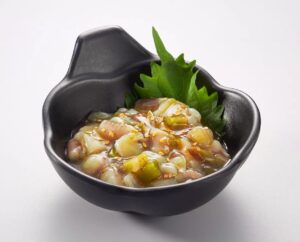
甜辣炸鸡 (tián là zhà jī) – Sweet and spicy fried chicken. A bit like China’s version of Korean fried chicken.
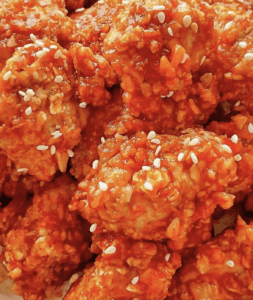
We move on to two more challenging local snack flavors from Lay’s Ruffles:
香辣臭豆腐 (xiāng là chòu dòufu) – Infamous stinky tofu with an aromatic chili sauce.
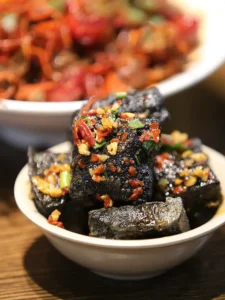
红油辣条 (hóngyóu làtiáo) – Super spicy, chewy strips of wheat gluten soaked in spicy red chili oil – it’s been a popular after school snack for 30+ years and plays on the nostalgia strings.
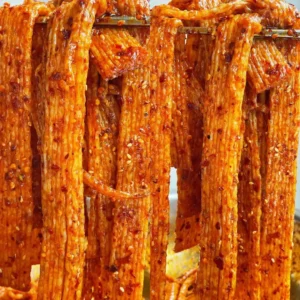
The other limited edition bags are representing a series of regional foods:
河北保定驴肉火烧 (Héběi Bǎodìng lǘròu huǒshāo) – Donkey “burger” (crispy flatbread stuffed with shredded donkey meat), a specialty from Baoding in Hebei province. Try it on UnTour’s Beijing Dinner Tour to learn about the history of the dish and the odd connection between donkeys and dragons.
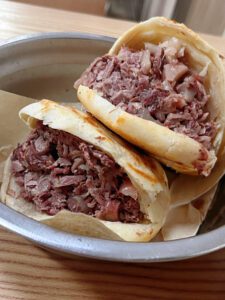
河北石家庄牛肉板面 (Héběi Shíjiāzhuāng niúròu bǎnmiàn) – Another dish representing Hebei – this time from Shijiazhuang – wide, hand-pulled noodles in a rich, beefy broth that features plenty of five spice (cinnamon, clove, star anise, fennel seed, and Sichuan peppercorn).
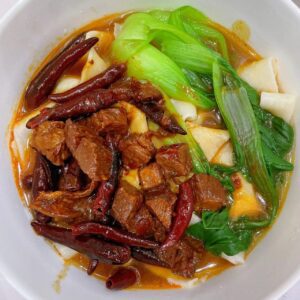
东北三省棒骨炖酸菜 (Dōngběi sān shěng bànggǔ dùn suāncài) – Stewed pork bones and pickled cabbage, from the northeastern provinces. The stew’s depth of flavor comes from the collagen and marrow released from the slow-cooked pork shank bones. It’s often served hot pot style.
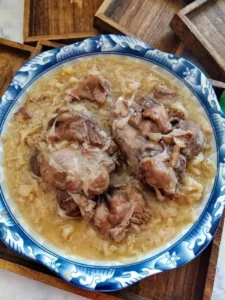
山东淄博烧烤 (Shāndōng Zībó shāokǎo) – DIY BBQ from Shandong, which gained immense popularity in early 2023 after Covid travel restrictions were reduced and thousands of people went to Zibo just to experience the BBQ firsthand. (Here’s a blog post about its meteoric rise, with tips on where to find a great version of it in Beijing.) Various meats or seafood are grilled over charcoal, wrapped in a flatbread with spring onions or cucumber, and then dipped in a variety of savory dips. It’s like Peking Duck’s bbq cousin.
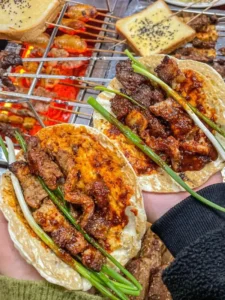
齐鲁山东煎饼卷大葱 (Qílǔ Shāndōng jiānbǐng juǎn dàcōng) – Giant spring onion (most famously from Zhangqiu, Shandong) rolled up in a jianbing (the base flatbread in the famous breakfast snack – featured in UnTour’s Shanghai and Beijing breakfast tours) with tiánmiànjiàng, a slightly sweet, umami heavy brown sauce.
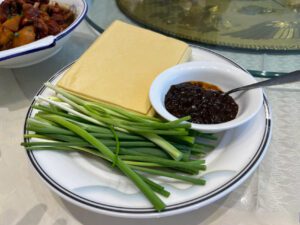
山东临沂炒鸡 (Shāndōng Línyí chǎo jī) – A stir-fried chicken dish from Linyi, Shandong with generous amounts of green and red chilies, ginger, garlic, and soy sauce. It’s a cold month comfort food.
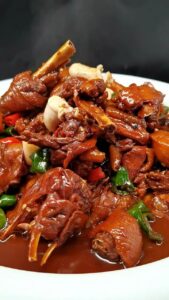
川香辣子鸡 (Chuānxiāng làzǐ jī) – Bite-sized morsels of bone-in chicken are deep fried with dried chili peppers, garlic, and Sichuan peppercorn and served in a haystack. A classic dish from the outskirts of Chongqing.
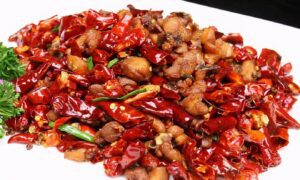
The series is a great reminder of just how diverse Chinese food gets (as featured in UnTour’s Shanghai Night Eats), and motivation to stay alert – China always has something unique in store!
If you’re interested, we ranked the flavors below, from least to most delicious:
12. Linyi chicken – tastes of green peppers, weirdly smells like smoked cigarettes
11. Jianbing – notes of onion but the finish isn’t pleasant
10. Zibo BBQ – BBQ flavor is too light
9. Pork stew – almost tastes of pork
8. Stinky tofu – oddly disappointing that there isn’t more stink
7. Fried chicken – sweet, garlicky taste, smells a bit like beer (or another person said “cereal”)
6. La tiao – straightforward spicy, not much different from the regular offering
5. Beef noodles – basically just 5 spice-flavored
4. Spicy chicken – definitely reminiscent of the dish
3. Donkey burger – meaty, star anise dominates
2. Fried pork – that Sichuan peppercorn shines through nicely
1. Octopus – wasabi and vinegar, thankfully not much octopus flavor – what’s not to like?!

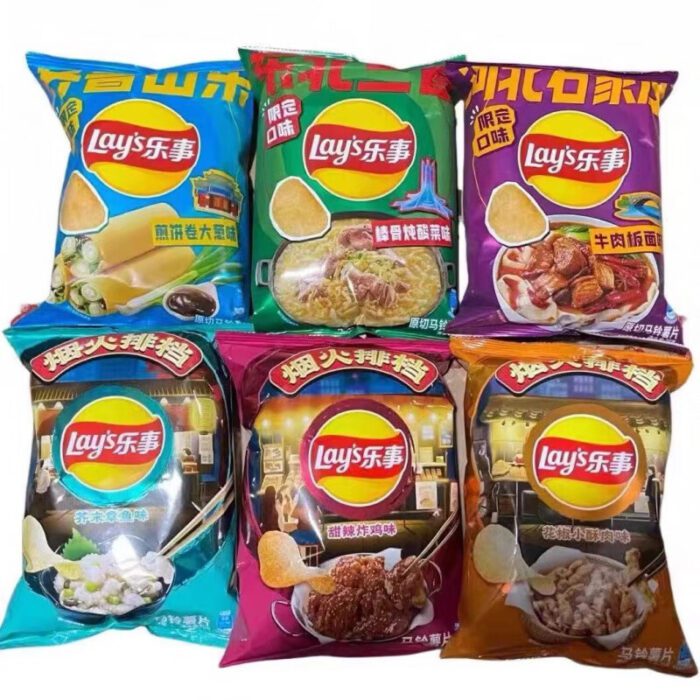

Leave a Reply